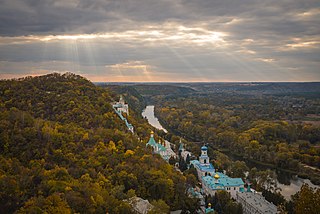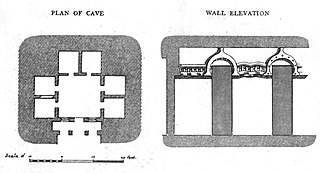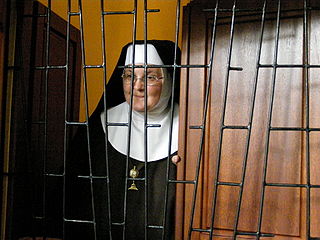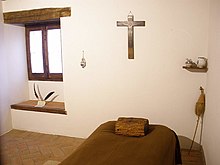Monasticism, also called monachism or monkhood, is a religious way of life in which one renounces worldly pursuits to devote oneself fully to spiritual work. Monastic life plays an important role in many Christian churches, especially in the Catholic, Orthodox and Anglican traditions as well as in other faiths such as Buddhism, Hinduism, and Jainism. In other religions, monasticism is generally criticized and not practiced, as in Islam and Zoroastrianism, or plays a marginal role, as in modern Judaism.

Pachomius, also known as Saint Pachomius the Great, is generally recognized as the founder of Christian cenobitic monasticism. Coptic churches celebrate his feast day on 9 May, and Eastern Orthodox and Catholic churches mark his feast on 15 May or 28 May. In Lutheranism, he is remembered as a renewer of the church, along with his contemporary, Anthony of Egypt on 17 January.

A monastery is a building or complex of buildings comprising the domestic quarters and workplaces of monastics, monks or nuns, whether living in communities or alone (hermits). A monastery generally includes a place reserved for prayer which may be a chapel, church, or temple, and may also serve as an oratory, or in the case of communities anything from a single building housing only one senior and two or three junior monks or nuns, to vast complexes and estates housing tens or hundreds. A monastery complex typically comprises a number of buildings which include a church, dormitory, cloister, refectory, library, balneary and infirmary, and outlying granges. Depending on the location, the monastic order and the occupation of its inhabitants, the complex may also include a wide range of buildings that facilitate self-sufficiency and service to the community. These may include a hospice, a school, and a range of agricultural and manufacturing buildings such as a barn, a forge, or a brewery.

The Carthusians, also known as the Order of Carthusians, are a Latin enclosed religious order of the Catholic Church. The order was founded by Bruno of Cologne in 1084 and includes both monks and nuns. The order has its own rule, called the Statutes, and their life combines both eremitical and cenobitic monasticism. The motto of the Carthusians is Stat crux dum volvitur orbis, Latin for 'The Cross is steady while the world turns'. The Carthusians retain a unique form of liturgy known as the Carthusian Rite.

A hermit, also known as an eremite or solitary, is a person who lives in seclusion. Eremitism plays a role in a variety of religions.

A monk is a man who is a member of a religious order and lives in a monastery. A monk usually lives his life in prayer and contemplation. The concept is ancient and can be seen in many religions and in philosophy.

A lavra or laura is a type of monastery consisting of a cluster of cells or caves for hermits, with a church and sometimes a refectory at the center. Lavra monasteries operate within the Orthodox and other Eastern Christian traditions; the name is also used by some Catholic communities. The term in Greek initially meant a narrow lane or an alley in a city.

Christian monasticism is a religious way of life of Christians who live ascetic and typically cloistered lives that are dedicated to Christian worship. It began to develop early in the history of the Christian Church, modeled upon scriptural examples and ideals, including those in the Old Testament. It has come to be regulated by religious rules and, in modern times, the Canon law of the respective Christian denominations that have forms of monastic living. Those living the monastic life are known by the generic terms monks (men) and nuns (women). The word monk originated from the Greek μοναχός, itself from μόνος meaning 'alone'.

Cenobiticmonasticism is a monastic tradition that stresses community life. Often in the West the community belongs to a religious order, and the life of the cenobitic monk is regulated by a religious rule, a collection of precepts. The older style of monasticism, to live as a hermit, is called eremitic. A third form of monasticism, found primarily in Eastern Christianity, is the skete.

Vihāra generally refers to a Buddhist monastery for Buddhist renunciates, mostly in the Indian subcontinent. The concept is ancient and in early Sanskrit and Pali texts, it meant any arrangement of space or facilities for dwellings. The term evolved into an architectural concept wherein it refers to living quarters for monks with an open shared space or courtyard, particularly in Buddhism. The term is also found in Ajivika, Hindu and Jain monastic literature, usually referring to temporary refuge for wandering monks or nuns during the annual Indian monsoons. In modern Jainism, the monks continue to wander from town to town except during the rainy season (chaturmasya), and the term "vihara" refers to their wanderings.

The Desert Fathers were early Christian hermits and ascetics, who lived primarily in the Scetes desert of the Roman province of Egypt, beginning around the third century AD. The Apophthegmata Patrum is a collection of the wisdom of some of the early desert monks and nuns, in print as Sayings of the Desert Fathers. The first Desert Father was Paul of Thebes, and the most well known was Anthony the Great, who moved to the desert in AD 270–271 and became known as both the father and founder of desert monasticism. By the time Anthony had died in AD 356, thousands of monks and nuns had been drawn to living in the desert following Anthony's example, leading his biographer, Athanasius of Alexandria, to write that "the desert had become a city." The Desert Fathers had a major influence on the development of Christianity.

A skete is a monastic community in Eastern Christianity that allows relative isolation for monks, but also allows for communal services and the safety of shared resources and protection. It is one of four types of early monastic orders, along with the eremitic, lavritic and coenobitic, that became popular during the early formation of the Christian Church.

Enclosed religious orders are religious orders whose members strictly separate themselves from the affairs of the external world. The term cloistered is synonymous with enclosed. In the Catholic Church, enclosure is regulated by the code of canon law, either the Latin code or the Oriental code, and also by the constitutions of the specific order. It is practised with a variety of customs according to the nature and charism of the community in question. This separation may involve physical barriers such as walls and grilles, with entry restricted for other people and certain areas exclusively permitted to the members of the convent. Outsiders may only temporarily enter this area under certain conditions. The intended purpose for such enclosure is to prevent distraction from prayer and the religious life and to keep an atmosphere of silence.

Eastern Christian monasticism is the life followed by monks and nuns of the Eastern Orthodox Church, Oriental Orthodoxy, the Church of the East and some Eastern Catholic Churches.
The degrees of Eastern Orthodox and Eastern Catholic monasticism are the stages an Eastern Orthodox monk or nun passes through in their religious vocation.

The Monastery of Saint Anthony is a Coptic Orthodox monastery standing in an oasis in the Eastern Desert of Egypt, in the northern part of the Red Sea Governorate close to the border with the Suez Governorate.

Coptic monasticism was a movement in the Coptic Orthodox Church to create a holy, separate class of person from layman Christians.
Monasticism is a way of life where a person lives outside of society, under religious vows.

Chariton the Confessor was an early Christian monk. He is venerated as a saint by both the Western and Eastern Churches. His remembrance day is September 28.

A religious community is a community who practice the same religion. The term is used to refer to members of a religion who live within a community, but not segregated from others and not dedicated solely to their faith. They worship together in a religious venue such as a temple, synagogue, church or mosque. In many religions, a group worshipping in common is called a congregation. In a narrower sense, a religious community is a group of people of the same religion living together specifically for religious purposes, often subject to formal commitments such as religious vows, as in a convent or a monastery. Most religious communities are part of the way religions are organized, and most religions have some form of Religious order.















